The State Fair in North Carolina is just a few miles from SAS headquarters, and therefore it's virtually impossible for it to slip by without me noticing it. There are two aspects of the fair that usually get lots of news coverage - what's the latest fair-food, and did we set any attendance records? There's not a lot of data about the food available (although I did create this fun graph a few years ago), but thankfully attendance numbers are published on the NC State Fair website daily!
Before we get started, here's an awesome photo my friend John took at this year's State Fair (be sure and click to see the full-size image, so you can take in all the detail!)
Now, let's analyze that attendance data ... Here's a screen-capture showing the top of the attendance table from the official webpage (click it to see the full table):
I decided to start my analysis by making a similar table, but with a few enhancements. First, I got rid of the colors, used a '.' rather than 'n/a', and sorted the table with the most recent years at the top. I think all these things make it easier to read.
Next, I used some tricky coding techniques to mark the highest attendance for each day in bright green. This involved using user-defined formats with color names, in combination with a somewhat obscure style option in Proc Print. I think this adds important information to the table, and makes it more of an analytic tool rather than just a table. Wow - looks like 2010 had several record-setting days!
Now that we know which days had the record attendance, let's find out which year had the highest total. And what better way to show that than a simple bar chart! Looks like 2010 was the record setter.
Now, how about some more detailed plots that allow us to visualize all the individual values in the table? Here's a simple plot of the data by day, with the latest (2016) markers in bright red. Note that the other markers are transparent blue, so you can see where multiple markers 'stack up' on top of each other (multiple/overlapping markers become darker, as the transparent colors combine).
I like that plot, but I'm sure the analysts and statisticians are already salivating for a box plot. I know it's not traditional to show all the markers when using a box plot, but I like to be able to see the spread of the actual data, so I like to include them.
But even the box plot didn't seem to show all the secrets that I knew were hidden in this data. Therefore I created another plot showing each year of data as a separate line - and with this graph, you can see an oddity in the data for the second Thursday (some of the values were high, and some of them were much lower).
And finally, I decided to color the lines by decade. It's not a beautiful graph (some would even disparagingly call it a spaghetti graph), but in this particular situation I think it provides some important insight that the other graphs did not!
With this graph, I was able to determine that the Thursdays with the lower attendance were from the 1980s and 1990s. And then I remembered that in more recent years there has been a big canned food drive on Thursdays where if you bring 5 cans of food to donate to the Food Bank of Central and Eastern North Carolina, you get into the fair for free. According to the fair website, since 1993, more than 4.4 million pounds of food have been donated by fairgoers. This transformed the traditionally lower-attendance Thursday into one of the higher-attendance days.
Although some portions of NC are still recovering from the flooding caused by Hurricane Matthew, we had nice weather during the fair week this year. This probably helped produce the good attendance numbers. I wonder if it would be possible to correlate fair attendance to weather data? Hmm ... maybe a topic for a future bog!
Another factor which might have helped lure in people this year was the awesome new attraction called the Flyer Sky Ride. It's a chair lift that carries passengers above the fairgrounds, from one end to the other. Here's a link to a cool video my friend David made from this ride.
I hope you had fun exploring & analyzing this data with me, and hopefully you have learned some tricks and techniques to use on your own data!

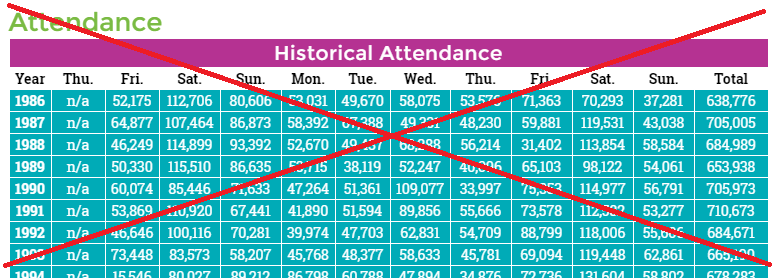

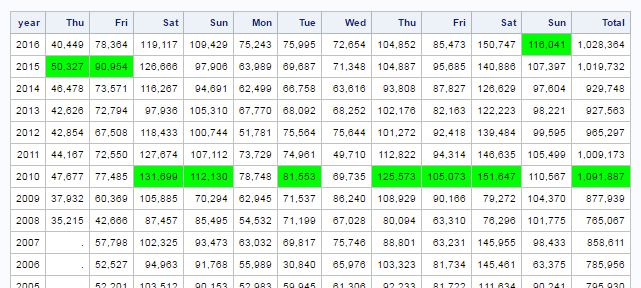
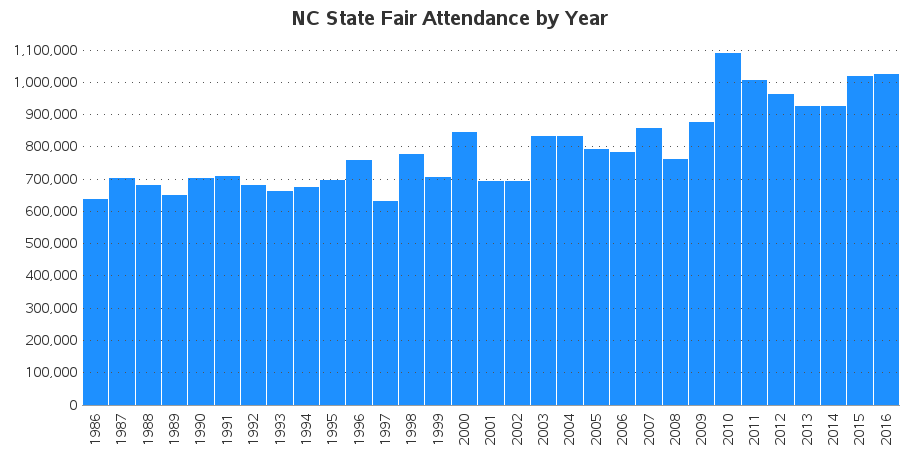
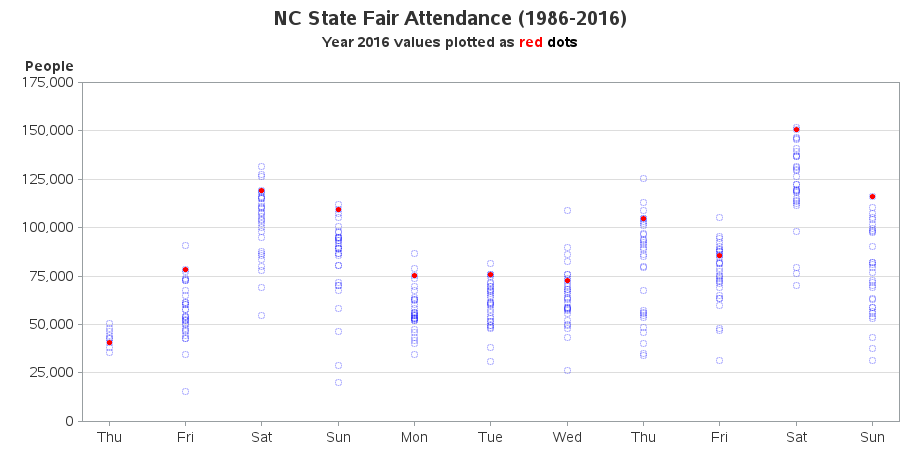
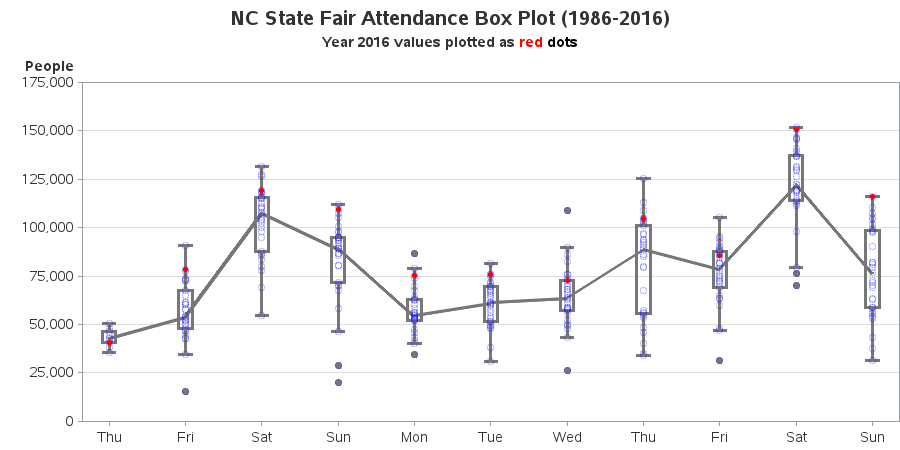




3 Comments
I have enhanced the interactive graphs so you can now click the plot markers, and see what the weather was like on that particular day! :)
Ksharp - I've run your code, and providing a link to the output, so people who don't have access to run SAS can see what you're suggesting:
http://blogs.sas.com/content/sastraining/wp-content/blogs.dir/24/files/2016/10/SGPanel_nc_statefair_attendance.png
Robert,
It would be look better if you are using Medal Graph.
data have;
infile datalines expandtabs dlm=' ';
input ( Year Thu Fri Sat Sun Mon Tue Wed Thu Fri Sat Sun Total) (: ?? comma32.);
array x{*} Thu--Total;
do i=1 to dim(x);
x{i}=x{i}/1000;
end;
drop i;
datalines;
1986
n/a
52,175
112,706
80,606
53,031
49,670
58,075
53,576
71,363
70,293
37,281
638,776
1987
n/a
64,877
107,464
86,873
58,392
67,388
49,331
48,230
59,881
119,531
43,038
705,005
1988
n/a
46,249
114,899
93,392
52,670
49,437
68,288
56,214
31,402
113,854
58,584
684,989
1989
n/a
50,330
115,510
86,635
53,715
38,119
52,247
40,096
65,103
98,122
54,061
653,938
1990
n/a
60,074
85,446
71,633
47,264
51,361
109,077
33,997
75,353
114,977
56,791
705,973
1991
n/a
53,869
110,920
67,441
41,890
51,594
89,856
55,666
73,578
112,582
53,277
710,673
1992
n/a
46,646
100,116
70,281
39,974
47,703
62,831
54,709
88,799
118,006
55,606
684,671
1993
n/a
73,448
83,573
58,207
45,768
48,377
58,633
45,781
69,094
119,448
62,861
665,190
1994
n/a
15,546
80,027
89,212
86,798
60,788
47,894
34,876
72,736
131,604
58,802
678,283
1995
n/a
42,479
69,279
89,237
43,358
56,257
58,686
93,179
47,796
130,092
68,940
699,303
1996
n/a
34,455
110,574
89,309
54,391
63,995
43,012
86,285
74,508
131,287
71,613
759,429
1997
n/a
44,106
54,500
28,736
56,008
65,099
82,675
57,399
77,299
136,939
31,379
634,140
1998
n/a
57,948
110,087
94,660
53,131
61,238
55,598
79,440
72,417
122,276
72,561
779,356
1999
n/a
49,812
104,352
19,762
55,650
57,779
26,276
89,598
87,812
136,832
79,574
707,447
2000
n/a
53,331
107,971
94,959
69,580
60,275
58,343
96,904
86,075
137,513
81,773
846,724
2001
n/a
47,940
77,747
46,540
51,921
54,116
57,330
84,975
84,538
113,450
76,620
695,177
2002
n/a
54,036
86,533
80,685
34,563
53,226
73,763
67,634
46,876
118,905
80,756
696,977
2003
n/a
61,364
115,016
97,655
54,579
65,923
64,152
96,614
78,855
129,589
70,208
833,955
2004
n/a
61,289
118,640
95,043
60,296
61,288
57,718
91,556
88,822
119,461
82,206
836,319
2005
n/a
52,201
103,512
90,153
52,983
59,945
61,306
92,233
81,722
111,634
90,241
795,930
2006
n/a
52,527
94,963
91,768
55,989
30,840
65,976
103,323
81,734
145,461
63,375
785,956
2007
n/a
57,798
102,325
93,473
63,032
69,817
75,746
88,801
63,231
145,955
98,433
858,611
2008
35,215
42,666
87,457
85,495
54,532
71,199
67,028
80,094
63,310
76,296
101,775
765,067
2009
37,932
60,369
105,885
70,294
62,945
71,537
86,240
108,929
90,166
79,272
104,370
877,939
2010
47,677
77,485
131,699
112,130
78,748
81,553
69,735
125,573
105,073
151,647
110,567
1,091,887
2011
44,167
72,550
127,674
107,112
73,729
74,961
49,710
112,822
94,314
146,635
105,499
1,009,173
2012
42,854
67,508
118,433
100,744
51,781
75,564
75,644
101,272
92,418
139,484
99,595
965,297
2013
42,626
72,794
97,936
105,310
67,770
68,092
68,252
102,176
82,163
122,223
98,221
927,563
2014 46,478 73,571 116,267 94,691 62,499 66,758 63,616 93,808 87,827 126,629 97,604 929,748
2015 50,327 90,954 126,666 97,906 63,989 69,687 71,348 104,887 95,685 140,886 107,397 1,019,732
2016 40,449 78,364 119,117 109,429 75,243 75,995 72,654 104,852 85,473 150,747 116,041 1,028,364
;
run;
proc transpose data=have out=want;
by year;
run;
ods graphics/width=2000 height=800;
proc sgpanel data=want noautolegend nocycleattrs ;
panelby _name_ / uniscale=row layout=columnlattice spacing=2 onepanel sort=data novarname;
dot year / response=col1 group=_name_ nostatlabel
markerattrs=(symbol=circlefilled size=10);
rowaxis discreteorder=data display=(nolabel) fitpolicy=none;
colaxis integer display=(nolabel);
run;